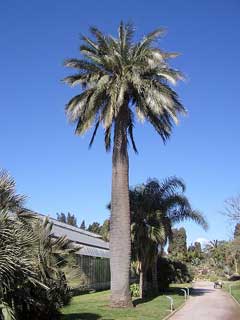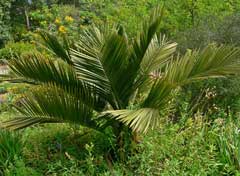 |
|
http://de.wikipedia.org/wiki/Benutzer:SteffenMP |
 |
| http://commons.wikimedia.org/wiki/User:Stan_Shebs |
Translate this page:
Summary
Physical Characteristics

 Jubaea chilensis is an evergreen Tree growing to 12 m (39ft) by 5 m (16ft) at a slow rate.
Jubaea chilensis is an evergreen Tree growing to 12 m (39ft) by 5 m (16ft) at a slow rate.
See above for USDA hardiness. It is hardy to UK zone 8 and is frost tender. It is in leaf all year. The species is monoecious (individual flowers are either male or female, but both sexes can be found on the same plant).
Suitable for: light (sandy), medium (loamy) and heavy (clay) soils. Suitable pH: mildly acid, neutral and basic (mildly alkaline) soils. It cannot grow in the shade. It prefers moist soil.
UK Hardiness Map
US Hardiness Map
Synonyms
J. spectabilis. Cocos chilensis
Plant Habitats
Woodland Garden Secondary; Sunny Edge;
Edible Uses
Edible Parts: Fruit Oil Sap Seed
Edible Uses: Oil
Sap - raw or cooked. A very sweet taste, it can be used as a refreshing drink[1, 2, 11, 61], concentrated into a syrup or fermented into a wine[183]. The tree is felled and the crown removed, the sap then begins to flow and, providing a thin section of trunk is removed daily, the sap will continue to flow for several months[2]. Yields of over 400 litres of sap can be obtained from a tree[2]. Fruit - candied and used as a sweetmeat[61, 183].The fruit is about 5cm in diameter[200]. Seed - raw or cooked[46, 61]. A pleasant nutty flavour raw[2], they are also used in sweetmeats[183]. The seed is about 5cm in diameter[231]. An edible oil is obtained from the seed[46, 61, 105, 177].
References More on Edible Uses
Medicinal Uses
Plants For A Future can not take any responsibility for any adverse effects from the use of plants. Always seek advice from a professional before using a plant medicinally.
None known
References More on Medicinal Uses
The Bookshop: Edible Plant Books
Our Latest books on Perennial Plants For Food Forests and Permaculture Gardens in paperback or digital formats.

Edible Tropical Plants
Food Forest Plants for Hotter Conditions: 250+ Plants For Tropical Food Forests & Permaculture Gardens.
More

Edible Temperate Plants
Plants for Your Food Forest: 500 Plants for Temperate Food Forests & Permaculture Gardens.
More

More Books
PFAF have eight books available in paperback and digital formats. Browse the shop for more information.
Shop Now
Other Uses
Basketry Brush Oil Paper Stuffing Thatching
The leaves are used to make baskets, brushes and for thatching[46, 61, 139]. Fibres from the plant are used as a stuffing material for mattresses etc[139]. A paper is made from the fibres in the trunk[139].
Special Uses
Carbon Farming
References More on Other Uses
Cultivation details
Management: Standard Regional Crop Staple Crop: Oil
We have no records of the cultivation needs of this plant in Britain. It is said in many books that it is not hardy in Britain but some trees have been growing outdoors in Britain at Torquay since 1900 and they were 7.5 metres tall in 1972[11, 166]. It will probably require a sunny sheltered position in a moist but well-drained soil[231]. Some reports say that it can tolerate several degrees of short-lived frost[200, 260]. Palms usually have deep penetrating root systems and generally establish best when planted out at a young stage. However, older plants are substantially more cold tolerant than juvenile plants[231]. In areas at the limit of their cold tolerance, therefore, it is prudent to grow the plants in containers for some years, giving them winter protection, and only planting them into their permanent positions when sheer size dictates[231]. Palms can also be transplanted even when very large. Although the thick fleshy roots are easily damaged and/or desiccated, new roots are generally freely produced. It is important to stake the plant very firmly to prevent rock, and also to give it plenty of water until re-established - removing many of the leaves can also help[231]. This species is sometimes cultivated for its edible fruit and seed plus its many other uses[139]. It is a very slow-growing plant that takes several years before it begins to form a trunk and takes up to 60 years to produce seed[139]. The tree is becoming very rare in its native range because it has been widely exploited for its edible sap. The trees are beheaded and a large quantity of sap exudes from the trunk. Unfortunately, the tree cannot produce side branches and so it dies after this treatment[139].
Carbon Farming
-
Management: Standard
Plants grow to their standard height. Harvest fruit, seeds, or other products. Non-Destructive management systems.
-
Regional Crop
These crops have been domesticated and cultivated regionally but have not been adopted elsewhere and are typically not traded globally, Examples in this broad category include perennial cottons and many nuts and staple fruits.
-
Staple Crop: Oil
(0-15 percent protein, 16+ percent oil). Some of these are consumed whole while others are exclusively pressed for oil. Annuals include canola, poppyseed, maize, cottonseed, sunflower, peanut. Perennials include high-oil fruits, seeds, and nuts, such as olive, coconut, avocado, oil palm, shea, pecan, and macadamia. Some perennial oil crops are consumed whole as fruits and nuts, while others are exclusively pressed for oil (and some are used fresh and for oil).
References Carbon Farming Information and Carbon Sequestration Information
Temperature Converter
Type a value in the Celsius field to convert the value to Fahrenheit:
Fahrenheit:
The PFAF Bookshop
Plants For A Future have a number of books available in paperback and digital form. Book titles include Edible Plants, Edible Perennials, Edible Trees,Edible Shrubs, Woodland Gardening, and Temperate Food Forest Plants. Our new book is Food Forest Plants For Hotter Conditions (Tropical and Sub-Tropical).
Shop Now
Plant Propagation
Seed - best sown as soon as it is ripe in a warm greenhouse. The seed can take 6 months to germinate[200]. Stored seed should be soaked for 12 - 24 hours in warm water as soon as it is received and then sown in a warm greenhouse. It can be very slow to germinate. The seed has a short viability. When they are large enough to handle, prick the seedlings out into individual pots and grow them on in the greenhouse for at least their first two winters. Plant them out into their permanent positions in late spring or early summer, after the last expected frosts, and give them some protection from the cold for their first few winters outdoors.
Other Names
If available other names are mentioned here
Native Range
SOUTHERN AMERICA: Chile (32-36 deg. S)
Weed Potential
Right plant wrong place. We are currently updating this section.
Please note that a plant may be invasive in one area but may not in your area so it's worth checking.
Conservation Status
IUCN Red List of Threatened Plants Status :

Growth: S = slow M = medium F = fast. Soil: L = light (sandy) M = medium H = heavy (clay). pH: A = acid N = neutral B = basic (alkaline). Shade: F = full shade S = semi-shade N = no shade. Moisture: D = dry M = Moist We = wet Wa = water.
Now available:
Food Forest Plants for Mediterranean Conditions
350+ Perennial Plants For Mediterranean and Drier Food Forests and Permaculture Gardens.
[Paperback and eBook]
This is the third in Plants For A Future's series of plant guides for food forests tailored to
specific climate zones. Following volumes on temperate and tropical ecosystems, this book focuses
on species suited to Mediterranean conditions—regions with hot, dry summers and cool, wet winters,
often facing the added challenge of climate change.
Read More
Expert comment
Author
(Moll.)Baill.
Botanical References
11200
Links / References
For a list of references used on this page please go here
Readers comment
© 2010, Plants For A Future. Plants For A Future is a charitable company limited by guarantee, registered in England and Wales. Charity No. 1057719, Company No. 3204567.